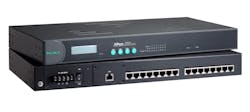One of the biggest challenges of converting a conventional building into one that’s intelligent is how to connect aging operational technologies (OT) to a modern Internet Protocol (IP) network for the purpose of centralized management and automation. The problem with many of these in-building OT components such as HVAC systems, elevators, fire alarms, and power meters is that they only offer outdated serial port connectivity for monitoring/management purposes. However, technologies are available that work as serial-to-IP conversion appliances, allowing for streamlined management and monitoring over any IP network. Let’s learn a bit more about serial-to-IP appliances and when they might be the right fit for modernizing your in-building OT equipment.
What is a serial-to IP appliance? Industrial and OT equipment was designed and built to last decades. As such, equipment that was deployed within a building long ago—but still fully functional—was not built with modern remote connectivity, monitoring and automation capabilities in mind. Instead, simplistic serial interfaces, often referred to as “COM ports” are used to locally configure and manage the equipment.
Serial-to-IP appliances and adapters connect to these serial interfaces and use software-selectable ports (i.e. RS-232, RS-422, RS-485) to connect the legacy serial interface to a modern IP network. The serial-derived communications are then converted to IP, which can be sent across any IP-based network infrastructure. Doing so allows administrators to remotely monitor and manage the equipment. Additionally, automation software can be used to pull out relevant data and automate various processes when preestablished thresholds and triggers are met. Ultimately, serial-to-IP interfaces allow for legacy equipment to be managed and optimized similar to brand new OT equipment that is IP-compatible directly from the manufacturer.
Are there any drawbacks to a serial-to IP appliances? As most IT professionals can attest to, keeping production deployments as simple as possible leads to an infrastructure that is more likely to be reliable and easy to manage/troubleshoot. From a network perspective, it is always ideal to work with devices that natively communicate using IP. OT equipment that only offers a serial interface for management purposes adds complexity and cost when retrofitting it to operate across an IP network. The extra hardware and software in the form of a serial-to-IP adapter or appliance add both cost and complexity to the overall architecture. Over time, this hardware/software can break or malfunction, creating a situation in which troubleshooting to a resolution can take more time than anticipated to achieve.
When OT equipment replacement is not an option. Unlike IT hardware/software that typically has a lifespan of three to five years, OT equipment tends to last far longer as the cost to replace it can be significant. Although building owners and operators are keen to the idea of modernizing their buildings to be more energy efficient and comfortable for occupants, the amount of money it would cost to replace aging OT equipment with modern alternatives simply can’t be justified. In these types of situations, serial-to-IP appliances are a great choice to gain many of the “smart building” benefits at a far lower price point. While this choice does add some cost and infrastructure complexity, most find that the benefits often outweigh the risks.
About the Author

Andrew Froehlich
Contributor
As a highly regarded network architect and trusted IT consultant with worldwide contacts, Andrew Froehlich counts over two decades of experience and possesses multiple industry certifications in the field of enterprise networking. Andrew is the founder and president of Colorado-based West Gate Networks, which specializes in enterprise network architectures and data center build-outs. He’s also the founder of an enterprise IT research and analysis firm, InfraMomentum. As the author of two Cisco certification study guides published by Sybex, he is a regular contributor to multiple enterprise IT-related websites and trade journals with insights into rapidly changing developments in the IT industry.
